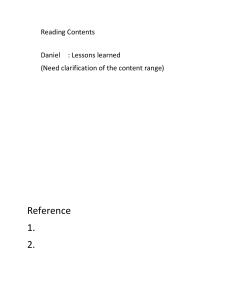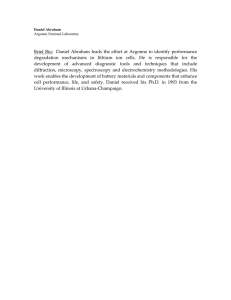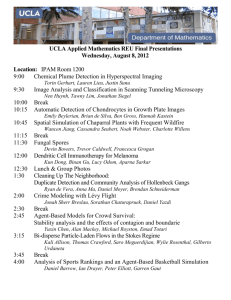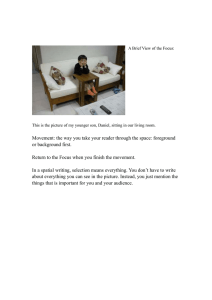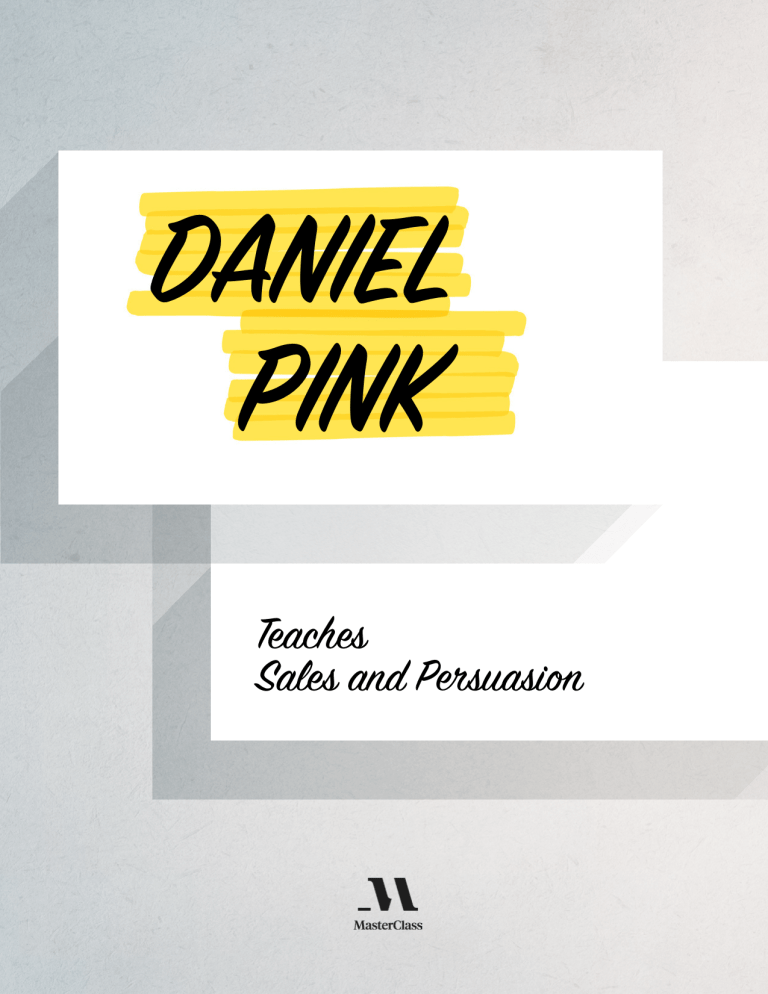
DANIEL PINK Teaches Sales and Persuasion 1 PITCH-PERFECT Daniel Pink has harnessed the power of persuasion, and he’s managed to use that power for good B y all objective measures, Daniel Pink didn’t need a career change: He’d been a Truman Scholar at Northwestern University, attended Yale Law School, received his J.D., landed a promising job in politics, and started working at the White House. By 1997, he was a bona fide success story, serving as the chief speechwriter for then–Vice President Al Gore. Even so, one day he decided to quit. What motivates a decision like that? The science of how our minds are changed, and how those changes are transformed into actions, has always fascinated Daniel. He wrote about his own rationale for leaving politics—lack of control over his schedule, too many professional obligations, not enough time with his wife and daughter, the casual oppression of wearing a necktie—in a landmark article for Fast Company. That story, and his subsequent journey into the world of freelancing, served as the basis for his first book, Free Agent Nation: The Future of Working for Yourself, which arrived in 2001. Since then, Daniel’s research and writing, focused on the behavioral and social sciences, have cemented his place among the world’s most influential management thinkers. Four of his books, including his most recent, When: The Scientific Secrets of Perfect Timing, have become New York Times bestsellers. He’s contributed to The New York Times, Harvard Business Review, and Slate, and he’s appeared as a regular guest on PBS, ABC, and CNN. In the last 15 years, he’s delivered more than 1,000 lectures to companies, universities, and nonprofits on six continents. His speech on the science of motivation is one of the most watched TED Talks of all time, with more than 36 million views across multiple platforms. Daniel offers unparalleled expertise on everything from getting a raise to pitching a product. He is an authority when it comes to motivation and persuasion, and his insight into framing a message for the modern age is unmatched. He has also managed to figure out how our minds—and the minds of those around us—actually work. Daniel’s hope is to not only give you a deeper understanding of the world around you but to provide you with practical tools to affect real objective change. Sales and Persuasion Terms You Need to Know AMBIVERT A person who shows a balance between the extrovert and introvert personality types. Ambiverts can be particularly effective persuaders. FUNDAMENTAL ATTRIBUTION ERROR The assumption that your behavior has more to do with your personality type than it does with environmental influences. COGNITIVE OVERLOAD When you are presented with more information, choices, or responsibilities than you can reasonably be expected to process. INFORMATION ASYMMETRY When one party in a transaction has more information about the product or service than the other party. CONFIRMATION BIAS The tendency to interpret new information in light of your existing beliefs rather than through rational analysis. INFORMATION PARITY When both parties in a transaction have equal access to information about the product or service in question. LOSS AVERSION The tendency to avoid losses more readily than seeking gains. ONE-WORD EQUITY The one-word distillation of a brand’s fundamental identity. Examples include “search” for Google or “safety” for Volvo. PRIMACY EFFECT When you’re presented with a list of choices or information, you tend to remember the earliest entries best. UNIQUE SELLING PROPOSITION The main attribute of your product, service, or business that sets it apart from the competition. 2 ILLUSTRATIONS BY JASON SCHNEIDER A Brief History of Sales From horse trading to "unicorn" companies 900–600 BC The development of metal coins allows more and more items to be sold outright rather than bartered. 3 1500s The Middle Ages practice of selling indulgences— which were believed to reduce a soul’s time spent in purgatory—galvanizes the Reformation. 1890 The golden age of the snake oil salesman— itinerant hawkers of “cure-all” elixirs—begins. 1936 IBM hires its first female salesperson, Gertrude Brooks. BRAVE NEW WORLD The age of predatory selling is over. Now, let’s rethink the approach W hen researching his 2012 book, To Sell Is Human, Daniel conducted a survey of 5,000 people. He asked for the first word that came to their minds when they thought of sales. Most of the adjectives were negative: “slimy,” “smarmy,” “aggressive.” It only takes one viewing of Cadillac Man to understand why. Yes, you know the sleazy used-car salesman. This archetypal character is patronizing, abrasive, and, above all else, predatory. He’s bent on sticking an unsuspecting buyer with an overpriced lemon. The sleazy used-car salesman relies on what’s called information asymmetry— knowing more about the product than the customer. But our understanding of sales has evolved more in the last decade than it did in the last century. Thanks to the internet and social media, information asymmetry has been replaced by information parity. Now, buyers often have as much (or, in same cases, more) knowledge about a product as sellers. Consumers can tap into an endless stream of choices and comparisons. They also have options for talking back, from leaving a product review on Amazon to disclosing salaries on Glassdoor, further breaking down the structure of information asymmetry. That is to say: The “buyer beware” culture, where slippery used-car salesmen thrived, has ceded to this new “seller beware” environment. Do wrong by a customer and your business and reputation are likely to suffer. Sellers are forced to take the high road. Bottom line: The 1940–'50s The postwar period sees the rise of the door-to-door salesman. Bibles, vacuums, and life insurance are commonly sold products. 1967 The first Dale Carnegie Training leadership course is held. Lessons are based on the principles of persuasion from Carnegie’s bestselling book, How to Win Friends and Influence People. paradigm of persuasion has shifted. The best response to this change? Make selling personal, and make it purposeful. Daniel believes in starting out with these two questions: If the other person does what I want, will they be better off? If the other person does what I want, will the world be better off? If the answer to these questions is “no,” it might be time to rethink your position. In sales today, idealism isn’t just a stance. It’s a practical methodology. You already do this, in one way or another, on a daily basis. You’re engaged in multiple interactions trying to persuade another person to think or behave a certain way. Want a raise? You’re selling the boss on your skills and value to the company. Need your kid to do their homework? You’re selling them on the merits of education—and of doing what you say. This means you’ve already got many of the tools needed to be successful in sales and persuasion. Like all humans, you’re something of a natural persuader, even if you don’t feel like one. There isn’t a specific personality type that’s inherently better at persuasion, either. Which means you don’t need to be an extrovert to be effective. We’re all in sales. 1992 The film adaptation of David Mamet’s play Glengarry Glen Ross, which takes audiences inside a highly dysfunctional sales firm, premieres. 2004 Salesforce, the cloud computing service specializing in customer management, holds its IPO. 4 THE ABCS OF SALES Updating a tired business aphorism I n the film version of Glengarry Glen Ross (1992), a master salesman—portrayed brilliantly by Alec Baldwin—is sent to energize a middling corporate real estate team. Pacing around the office bullpen, he berates them and insists they stick to the ABCs of sales: Always Be Closing. Baldwin’s character is out of step with our times, to say the least. Just as salespeople have changed, so too have the ABCs. When Daniel talks about the ABCs of sales, he means something different entirely: Attunement, Buoyancy, Clarity. A IS FOR ATTUNEMENT “When human beings have their own reasons for doing something, they’re more likely to do it; they’re more likely to believe in the reasons for doing it; they’re more likely to sustain that behavior,” Daniel says. Attunement is an ability to get out of your own head and into the head of the person you’re attempting to persuade. It’s not about coercion; it’s about seeing the situation through their eyes. This skill, called perspective-taking, requires you to: 1. S ee where a person’s coming from. What motivations, concerns, and biases do they bring to the table? 2. U nderstand what they’re saying. You’ve got to truly grasp what they want. 3. H onor their point of view. Respecting their position can build a bridge to agreement. Be advised: The more powerful the person, the worse they are at perspective-taking. If you’re in a position of authority, dialing back your power level will actually help here. Are you a manager trying to persuade an 5 employee to take on additional work? Imagine yourself as their peer for a moment. How would you persuade them to take on the new project if you didn’t have the authority to simply assign it? How would you feel if you were the employee being asked to take on new work? As an exercise, try some perspective-taking with the people in your life—your kids, your spouse, your friends. Managing power discrepancies between you and the person you’re attempting to negotiate with is critical. When you’re selling to someone with more power than you—for instance, asking a manager about a raise—keep these tips in mind: Approach the interaction in terms of how your promotion will ultimately be beneficial to your manager. Help your manager see problems in a different light; find the right problem that your promotion will help solve. Appeal to your manager’s sense of fairness (and don’t hesitate to hint at the fact that you may quit if treated unfairly). When dealing with people with less power than you, reduce your own feelings of power. Practice intellectual humility; no matter how brilliant you are, you don’t have all the answers. Doing this will allow your perspectivetaking to really take off. Empathy is the complement to perspective-taking. By zeroing in on a buyer’s emotions, you’re increasing the chances of getting them to act as you wish. Bear in mind that persuasion is a dialogue; it’s the hunt for common ground. What was once purely about irritation (getting someone to do what you want) is now also about agitation (getting someone to do what they should do and will ultimately want to do). The latter is a better method because it spurs a person’s own motivations for making change. B IS FOR BUOYANCY C IS FOR CLARITY Buoyancy measures your ability to float “in an ocean of rejection,” as Daniel calls it. As a seller/persuader, you’re going to hear “no” many more times than “yes.” Managing this means equipping yourself to deal with rejection—a.k.a. becoming more buoyant. Want to build up your own raft? Make an effort to de-catastrophize rejection. What seems like the end of the world—well, it just isn’t. This type of thinking can be the product of a three-headed beast of self-biases. We call them the Three Ps. “Clarity is simply the ability to see a situation in a fresh light and help people surface problems they didn’t realize that they had,” Daniel says. Effective persuasion tactics are born from providing clarity. In the past, sales was a role that revolved around expertise—the seller knowing more than the buyer. But the era of information parity means shifting the persuader’s role from gatekeeper to curator. It also means shifting from problem-solving to problem-finding. The salesmen of yore would have said, “It looks like you’re in the market for a vacuum.” Now, the smart salesperson says, “Tell me about your house.” Think about the problems around your home or office that you’re currently attempting to solve. Next, take a step back and ask: “Is there a root cause to these problems that I may be missing?” Sure, you might be in the market for a vacuum cleaner because your floors are dirty. But why are your floors dirty? If it’s because of your pup, Fido, maybe you’re actually in the market for a dog groomer, not a vacuum. To that end, part of providing clarity as a salesperson hinges on being an expert on issues that contextualize the transaction. Today’s vacuum salesperson actually needs to be in the home cleanliness business—a knowledgeable figure in the field of maintaining a tidy, healthy environment—not just a pro regarding the inner workings of a Dyson. This is where you’ll use your expertise to guide the customer to the best solution for his or her particular need. Your worth comes from an ability to synthesize knowledge for the buyer’s benefit. In terms of persuasive techniques, don’t hesitate to rely on social proof, which involves using the pressure of peer comparison to influence behavior. Telling the head of a firm that his or her computer system is extremely outdated can work; telling him or her that it’s extremely outdated when compared with the company’s biggest competitor can work even better. This moment of clarity for your customer might result in a transformative purchase for them—and a transformative commission for you. Personal Bias You tend to believe rejection is somehow a referendum on who you are as a person. This isn’t necessarily correct. If you get rejected during a sale, look for all the ways this decision wasn’t based on who you are or what you did (or didn’t) say. There might be other factors at play. Pervasive Bias Rejection can beget a loop of negative confirmation. You think: “This always happens!” But in reality, it doesn’t always happen. Focus instead on all the times you’ve prevailed in the past. Permanent Bias If it’s large enough, even one rejection can feel like an indelible black mark on your status as a persuader. Truth is, this single rejection is far from the final word. Think about all the ways things aren’t ruined. Then get back up, dust yourself off, and start selling again. Giving Yourself a Pep Talk: The 30-Second Primer The old-school approach to sales relies on positive, affirmative self-talk (“You can do this!”). Instead, try using interrogative self-talk (“Can I do this? Okay, how?”). This forces you to answer questions and, in doing so, to plan, strategize, and rehearse. The result is improved overall performance. 6 SOCIAL STUDIES Daniel’s perspectives on sales and persuasion are rooted in the behavioral sciences. Brush up on some of his most trusted academic papers and see how they improve your game “Power and Perspectives Not Taken” PSYCHOLOGICAL SCIENCE 17, NO. 12 (2006) How does drawing an E on your forehead— mirrored or oriented toward yourself—relate to power? “It's Not All About Me” PSYCHOLOGICAL SCIENCE 22, NO. 12 (2011) Here’s a neat side effect of hubris: Altruistic motivation can actually work better than self-interest. “A Room With a Viewpoint” JOURNAL OF CONSUMER RESEARCH 35, NO. 3 (2008) Hotel guests are asked to reuse towels in different ways, resulting in an intriguing finding about how establishing (and adhering to) norms impacts our behavior. “Why It Pays to Get Inside the Head of Your Opponent” PSYCHOLOGICAL SCIENCE 19, NO. 4 (2008) Empathy is an essential tool in social interactions but can be particularly critical in negotiations. 7 “Chameleons Bake Bigger Pies and Take Bigger Pieces” JOURNAL OF EXPERIMENTAL SOCIAL PSYCHOLOGY 44, NO. 2 (2008) Wherein mimicry is shown to help facilitate successful negotiations. “When Blemishing Leads to Blossoming” “To Do or to Have? That Is the Question” JOURNAL OF CONSUMER RESEARCH 38, NO. 5 (2012) JOURNAL OF PERSONALITY AND SOCIAL PSYCHOLOGY 85, NO. 6 (2003) A small dose of negative information, added to an otherwise positive description, yields favorable results. “Mimicry for Money: Behavioral Consequences of Imitation” JOURNAL OF EXPERIMENTAL SOCIAL PSYCHOLOGY 39, NO. 4 (2003) Wherein mimicry is shown to help facilitate larger payouts. Or, more precisely: Do experiences make people happier than material possessions? “The Preference for Potential” JOURNAL OF PERSONALITY AND SOCIAL PSYCHOLOGY 103, NO. 4 (2012) The suggestion of possibility can beat the reality of achievement. “Judgment Under Uncertainty” “Birds of a Feather Flock Conjointly (?)” SCIENCE 185, NO. 4157 (1974) PSYCHOLOGICAL SCIENCE 11, NO. 5 (2000) Three heuristics, highly economical and typically effective, beget systematic (and predictable) errors. “Assessing Creativity in Hollywood Pitch Meetings” ACADEMY OF MANAGEMENT JOURNAL 46, NO. 3 (2003) Analyzing the twotiered system our brains use while considering creative pitches. “Do You Want the Good News or the Bad News First?” PERSONALITY AND SOCIAL PSYCHOLOGY BULLETIN 40, NO. 3 (2014) Researchers use three studies to refine (and answer) an age-old question. “Explanatory Style as a Predictor of Productivity and Quitting Among Life Insurance Sales Agents” JOURNAL OF PERSONALITY AND SOCIAL PSYCHOLOGY 50, NO. 4 (1986) The jaunty title alludes to the study’s finding: rhyming, like repetition, sets off mental shortcuts to attribute unearned trust. “People Search for Meaning When They Approach a New Decade in Chronological Age” PROCEEDINGS OF THE NATIONAL ACADEMY OF SCIENCES 111, NO. 48 (2014) How our perception of time, in epochal increments, frames our motivations and decision-making. Certain pessimistic verbiage leads to poor productivity—and decreased resilience when things go south. “Motivating Goal-Directed Behavior Through Introspective Self-Talk” PSYCHOLOGICAL SCIENCE 21, NO. 4 (2010) A look at the science of self-starting, which focuses on how we speak to ourselves—and how it affects our attitude and performance. “When Three Charms but Four Alarms” JOURNAL OF MARKETING 78, NO. 1 (2014) From ads to stump speeches, researchers find that three claims persuade but four is a bridge too far. “Saving the Last for Best” “Rethinking the Extraverted Sales Ideal” PSYCHOLOGICAL SCIENCE 24, NO. 6 (2013) Conventional wisdom, which assumes that gregarious salespeople are more successful, doesn’t hold up under scientific scrutiny. “Can Losing Lead to Winning?” MANAGEMENT SCIENCE 57, NO. 5 (2011) PSYCHOLOGICAL SCIENCE 23, NO. 2 (2012) Within a sequence of events, people tend to see the final one more positively. Looking at more than 18,000 basketball games, the analysis finds that being slightly behind at halftime can increase the odds of winning. 8 9 MAP QUEST The social scientist’s cheat sheet for group dynamics W ant to visualize how influence works in a group setting? Try making what Daniel calls a discussion map. Use a circle and a speaker’s first initial to represent everyone in a discussion. Every time someone speaks, draw an arrow from them to whomever they’re addressing. When the discussion wraps, take stock and analyze. Keep a few things in mind here. People who talk a lot (person A) are often the people who are struggling for influence. Also, when someone stays relatively quiet (person D), make sure to look at how often they’re being addressed by others. If they don’t say much but are getting a disproportionate amount of attention, it signals that they have leverage. Breaking down influence might seem high-stakes, but you don’t need to sit in with a Fortune 500 boardroom to get some insight. A discussion map works around the dining room table or even when you’re out with friends. Give it a shot. It’ll give you a better idea about the power dynamics within group settings. 10 GET YOUR HEAD IN THE GAME There’s some science behind making your pitches as persuasive as possible Persuasive framing allows you to contextualize a sale on the terms you set. While you don’t need to use a frame every time, this can be a remarkably effective tool. A major part of knowing how to frame a pitch persuasively comes from understanding that humans inherently fall victim to cognitive bias: We tend to let our subjective reality—or how we perceive the world—take precedence over an objective reality. Daniel cites a few different cognitive biases: loss aversion, opportunity cost, and experiential value. These three biases can be distilled down into three primary types of persuasive framing: The Experience Frame draws on people’s tendency to value experiences over goods and services. In attempting to sell someone a house, you sell them on the experiences made possible by home ownership rather than the property itself. The Potential Frame embraces the fact that potential is often more persuasive than current performance. When going for a promotion, you tell a boss all the ways you’d succeed in the new role instead of listing ways you’re competent in your current role. The Loss Frame contextualizes a sale around what the buyer stands to lose if they don’t hit the bid. Selling someone insurance is the classic example of this frame. Cognitive bias ultimately affects how and why people make a decision. In sales, it’s always beneficial to consider cognitive bias when you’re pitching—it’ll help you decide which of the three frames above might work best in a particular circumstance. “If you understand cognitive biases, you understand message framing, you understand human thinking,” Daniel says. For more on cognitive bias, opportunity cost in business, and how opportunity cost factors into business decisions, head to masterclass.com. 11 COLLABORATION IS KEY A few pointers to help you seal the deal “[Effective] pitches…invite the other side in as a collaborator,” Daniel says. Our conventional notion of an effective pitch—you do a special song and dance, the investor whips out their checkbook—is pretty antiquated. As Daniel reminds us, the concept of an “elevator pitch” (so named because the pitch should be no longer than 20 or 30 seconds, or the length of a short elevator ride) was actually used to sell elevators before the Civil War. In truth, crafting an effective pitch these days is much like any other sale: You have to find common ground with the buyer, invite them to collaborate, and show how their interests are served by agreeing to the terms. And, like persuasive framing, there are a variety of pitch techniques you can employ. One of them is the Question Pitch. This turns your pitch statement into an interrogative, transforming “I have the world’s greatest carbon monoxide detector” into “How much is it worth to you to protect your family?” Asking a question immediately gets the person you’re pitching involved by inviting a response. That’s why questions are often more effective than statements. Another is the Rhyming Pitch. Despite seeming outdated, this technique has been shown to be persuasive. (“See the USA in your Chevrolet” remains a classic, no?) We’re primed to be pleased by this type of language from an early age. While you don’t want to overuse it, deploying the occasional rhyme as part of your pitch can be effective. TIMING IS EVERYTHING Your internal rhythms have a more profound effect on your productivity than you might realize Persuasion, fundamentally, is about human nature. And one of the most important methods for understanding human nature is to appreciate our inherent rhythms. Try thinking about each day in three stages: Peak: Early to midmorning. This is the time when you’re most alert and equipped for analytical work. Big decisions are best made during this period. Trough: Late morning to early afternoon. This is the time when your performance might start to lag and your energy levels may begin to drop. It’s a time best saved for administrative work. Recovery: Late afternoon to early evening. This is the time when your energy levels begin to rebound, making it ideal for iterative or creative work. Bear in mind that these levels of productivity don’t necessarily apply to all people. You might be different, Daniel says, depending on your chronotype. (Take a moment to self-identify: Are you a “lark” or an “owl”?) Regardless, this daily flow can be a useful lens for tackling projects and even approaching larger, broader life goals. In addition to breaking each day up into phases, you can also try viewing projects from a perspective that might look especially familiar to writers: Beginnings: Pick a date or day of the week that makes symbolic sense to begin something big. Starting on a Monday (rather than, say, a Thursday) is more likely to help your project be a success. Also, do a premortem by generating a list of potential stumbling blocks and blind spots as part of your preparation. Once you identify those, formulate a plan for how to avoid them and jot down a few practical solutions in case they do arise. Middles: These are tricky. Sometimes they drag us down; research shows that happiness tends to lag in midlife. But when used properly, they can also fire us up. In that spirit, try using project midpoints as a form of motivation. If you can think of yourself as slightly behind when reaching the midpoint of a project, it might encourage you to pick up the pace. Endings: They should energize you. People tend to push harder once the end is in sight. Who doesn’t love going out on top? Use the looming finish line of a project as an opportunity to make things happen. As a persuader, you should aim to get your audience to see the endgame. That’s because endings help encode the message; what happens at the end of an experience has an outsize effect on our perception of the event in its totality. In practice, this means the end of your sell should be designed to leave a lasting impression. Save your best lines, and your most convincing arguments, for the wrapup. Finish strong. Master Minds The neuroscience revolution has shed new light on how our brains react to being persuaded. (Literally.) Studies have found a link between persuasive arguments and increased brain activity. This occurs specifically in the prefrontal cortex, the area involved in decision-making, personality expression, and social behavior. Chalk up another win for perspective-taking, too. Per Matt Lieberman, a PhD and social cognitive neuroscientist at the University of California in Los Angeles, data is “consistent with the notion that if you can get someone to step into your shoes psychologically, you might be halfway home in terms of persuading them to see the content of the message the way you want them to.” 12 LIVE BY YOUR WITS On the importance of ad-libbing I n the old-school approach to sales, you’d likely be reciting a mental script to your mark. (Cue card: “I bet you’re asking yourself how this product can change your life. Well, let me tell you…”) But like the overall role of the persuader, this facet of sales has changed with the rise of information parity. Buyers may already have questions lined up for you. And they may know enough about your product to push back against your claims. Be ready to think on your feet—a.k.a. be ready to improvise. Not a natural improviser? No worries. The world of improvisational theater is an unlikely ally for developing your soft skills. Before you laugh, know that top business schools like Duke and Stanford have looked to improv for lessons on adaptability. Here are three basic and practical concepts that translate from the stage to sales. 1. R ather than a simple “yes” in response to a comment, question, or concern, say “yes, and…” Use this response as a connector, bringing you—and the person you’re attempt13 ing to persuade—closer together. You can even use this phrase to disagree (“Yes, I see what you mean, and here’s how I’d like you to see it…”) without seeming too confrontational. 2. Listening is a skill. It’s also a form of information gathering, which can point to your next cue. Pay close attention to what your customer has to say, and read between the lines: Their response might propel a subtle offer to collaborate, leading to the common ground that makes a sale. 3. Make the other side look good. This isn’t to say you should pander to your customer or flatter them simply for flattery’s sake. Instead, make them feel heard and respected. When they offer great insights, tell them so. As Daniel says, “When people feel elevated, they’re more likely to go along with you.” THE FINE PRINT What should an effective persuader keep on their bookshelf? Daniel shares a few of his favorite titles The book: Influence: The Psychology of Persuasion The author: Robert Cialdini Daniel’s notes: “First published in 1984, this book remains the most important and insightful work on the science of persuasion.” The book: Give and Take: Why Helping Others Drives Our Success The author: Adam Grant Daniel’s notes: “A premier organizational psychologist explores why generosity boosts influence.” The book: Made to Stick: Why Some Ideas Survive and Others Die The authors: Chip Heath and Dan Heath Daniel’s notes: “A practical guide to selling your ideas through the principles of simplicity, unexpectedness, concreteness, credibility, emotions, and stories.” The book: Bias: Uncovering the Hidden Bias That Shapes What We See, Think, and Do The author: Jennifer L. Eberhardt Daniel’s notes: “Among the steepest barriers to attunement and clarity is bias, especially implicit bias. The research gathered here will expand your vision, your mind, and maybe even your heart.” The book: The Person and the Situation: Perspectives on Social Psychology The authors: Lee Ross and Richard E. Nesbitt Daniel’s notes: “When we try to anticipate other people’s responses, should we focus on the individual or the context she’s in? The answer, says this nuanced book, is ‘yes.’ ” The book: The Art of Gathering: How We Meet and Why It Matters The author: Priya Parker Daniel’s notes: “Human beings are herd animals. We often make collective decisions. This thoughtful primer shows how to bring groups together to find solutions and deepen meaning.” The book: Getting to Yes: Negotiating Agreement Without Giving In The authors: Roger Fisher and William Ury Daniel’s notes: “I read this slim volume 30 years ago and still rely on its insights and practices.” The book: Metaphors We Live By The authors: George Lakoff and Mark Johnson Daniel’s notes: “Take it from Aristotle: ‘The greatest thing, by far, is to be a master of metaphor.’ ” The book: Norton Anthology of Poetry The editors: Margaret Ferguson, Tim Kendall, and Jo Salter Daniel’s notes: “Poets are persuaders because, as one of them put it, poetry represents ‘maximum efficiency of expression.’ ” The book: Improvisation for Theater The author: Viola Spolin Daniel’s notes: “Sales scripts are relics, so effective sellers must improvise. Practice those improv skills with this classic collection of exercises.” 14
